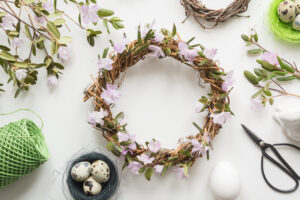
Wreaths are no longer just for Christmas. Beautiful door arrangements are becoming popular all year round, never more so than at Easter. In this article we share how to make an Easter Wreath, with some great tips, links to guides and design ideas.

Materials You Will Need
A wreath base
Floristry wire or a glue gun
Garden shears or flower scissors
Ribbon or bright coloured material to create a hanging loop and/or a bow
Greenery, Flowers (dried, fresh cut or artificial)
Easter themed accessories.
The Wreath Base
The base of most wreaths is made from branches or sticks of a springy wood like rattan, wicker or willow. If you don’t have access to a ready supply of these, or if you prefer to focus on the decoration side of this craft project, you can buy a ready-made base wreath like this one from Hobby Craft.
If you want to have a go at making your own base wreath, try the step-by-step willow wreath tutorial from craftinvaders.co.uk.
Now we have our base it is time to think about the decorations.
Theme and Colour Scheme
When thinking about the design of your Easter Wreath, as with all craft projects, it is a good idea to have a design or plan. Choose your theme or colour scheme before you start. Will you go for a pretty pastel look, or will you adorn your wreath with bold, bright florals? Which accessories will you choose? There are so many things associated with Easter; bunny rabbits, chicks, eggs, religious symbols, birds, carrots etc. Trying to add some of everything can soon make your wreath look rather busy, so decide upon one or two accessories so as not to detract from your flora and fauna.
Adding Accessories
To secure your accessories to your door wreath you may need a hot glue gun. If you would rather avoid using hot glue, try to choose accessories that can be secured with the floristry wire.
Natural, Dried or Artificial Foliage
When choosing your foliage, bear in mind whether you will want to use the wreath again next year. Whilst fresh cut foliage and flowers will always look better, they will of course start to wilt the moment you cut them. Not a problem if the making of your Easter wreath is to become an annual tradition! Fresh cut Tulips, Daffodils, Gypsophila, Moss and Ivy will all look stunning when artfully arranged on your Easter wreath.
Dried flowers can be a good compromise if you want a wreath that will last longer, although dried flowers can be rather delicate in adverse weather, so perhaps better for indoor use. Varieties of lavender, dried grasses and laurel can make a stunning impact and of course the lavender will emit a delicate aroma too.
Artificial foliage will last much longer than either dried or fresh cut items. You can choose from a much wider selection of flowers, varieties like roses and peonies that will typically wilt too fast when fresh, will last for years. Artificial doesn’t have to mean unrealistic there are some beautifully realistic artificial flowers available from online retailers like justartificial.co.uk that will look wonderful on your Easter wreath for years to come.
Adding Foliage
For fresh and dried flowers, it is advisable to use floristry wire to secure them to the wreath, for the more sturdy artificial flowers you can thread these into and through the wreath to secure them, simply snip any excess stems with your shears or flower scissors.
Finishing Touches
Hanging your wreath is going to be a consideration, specialist wreath door hooks like this one from Sarah Raven can be a stylish solution that won’t damage your door. You can use a bright ribbon to create a hanging point. Bows can be made from almost any material and will make a lovely finishing touch.
We hope this article has inspired you to have a go at making your own Easter wreath, we can’t wait to see them as we travel around the area.



